




By Lesdy Hernandez News Reporter
As San Marcos sees a wave of business closures, experts weigh in on a question: What does it take to build and sustain a successful business in this city?
Hastings Books, Torchy’s Tacos, Planet K, Half-Prices Books and Orangetheory Fitness are only some of the businesses that have closed in San Marcos in the past three years.
Earth Burger, which was located on East Hopkins Street, announced its closure in January 2024 after six years of operating in San Marcos.
In a Feb. 1, 2024 interview with The Star, Ellen Evans, director of Community Love at Earth Burger, said the decision was influenced by the need to adapt to the evolving market dynamic in San Marcos and to open up the market for future franchises.
“It was time for us to take a look at where our strengths are and where we were putting our efforts in and focusing more on our corporate stores here in San Antonio,” Evans said.
According to Page Michel, president and CEO of the San Marcos Area Chamber of Commerce, with San Marcos being a high-growth region, local businesses are experiencing supply chain issues, increases in inflated prices and difficulty finding enough employees.
According to the United States Department of Agriculture (USDA) Consumer Price Index (CPI), overall food prices are expected to rise in 2025, and restaurant purchases increased by 0.2% in January 2025, marking a 3.4% increase compared to January 2024.
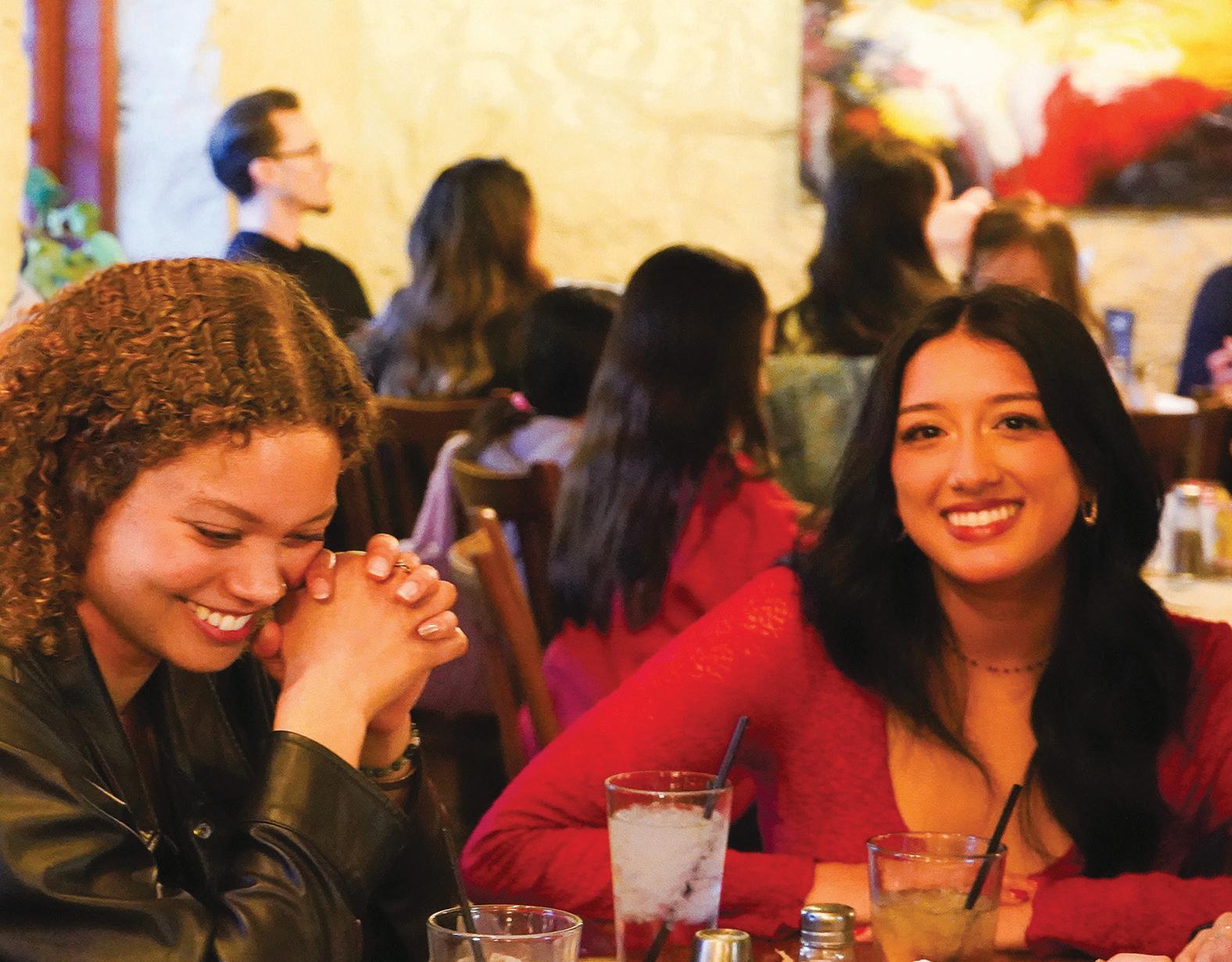
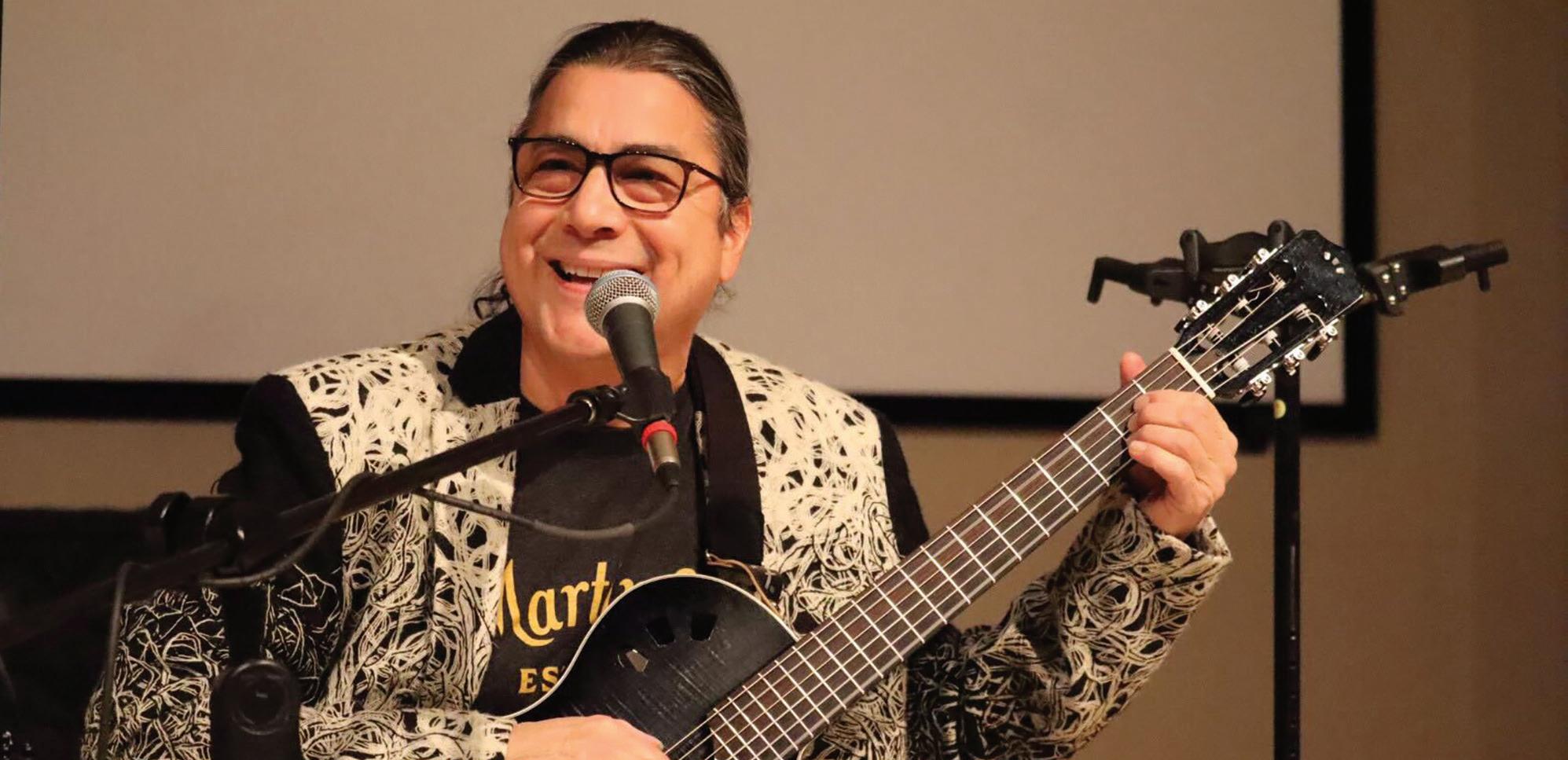
By Cassandra Tamez Life & Arts Contributor
Classical, Latin rock, pop, jazz, easy listening, country blues and original material were all part of Edgar Cruz’s performance, reflecting on his life’s journey on Feb. 24.
Brother of Mark Cruz, professor of instruction at the school of music, Edgar began playing the guitarron to accompany his father, an accomplished Mariachi musician. He credits his father with inspiring him because of his skill in playing technically challenging solo guitar pieces.
His introductory song “La Bamba” paid tribute to his father, who was born and raised in Mexico and moved to Oklahoma City in the 1950s to assist Edgar’s uncle
in establishing a Mexican restaurant. Edgar portrayed his father as a mariachi guitar player who utilized his versatility and skill to entertain restaurant patrons of all backgrounds.
“If there was a grandmother, he’d play ‘Over the Rainbow,’” Edgar said. “If there was a cowboy, he’d play ‘Ghost Riders in the Sky.’ If there was a teenager there, he’d play the Pink Panther theme.”
By
The Texas State University Police Department (UPD) plans to employ nine more officers by June in response to a shortage in sworn officers.
According to UPD Chief Matthew Carmichael, the department currently has a shortage of 11 sworn officers. He said the department can employ up to 37.5 sworn officers, including a part-time sex crime investigator.
Sworn officers are officers licensed by the Texas Commission on Law Enforcement and sworn in to a law enforcement agency.
“We’re struggling, not unlike every other agency in the U.S., and the challenge is hiring,” Carmichael said. “Hiring at this time, it’s just difficult to get applicants alone... which is challenging for us because of what you’re seeing nationally.”
Until UPD reaches higher staffing levels, Carmichael temporarily reassigned officers who may normally have other duties, such as detectives, who previously were in charge of investigating cases, to patrols. Carmichael said he believes police patrols are the most important thing a department can do.
By Hope Jimenez News Contributor
A new H-E -B set to open on east Interstate 35 is sparking debate about its potential to improve local food access. The 114,000 square-foot H-E-B located at I-35 and McCarty Lane will possibly provide a solution to low food access areas, formerly referred to as
are geographical
areas where residents have limited grocery stores. For some, the new H-E-B will address mobility issues on the east side of I-35 for residents who may not have the means to travel to grocery stores in the city. Residents in east San Marcos currently rely on smaller grocery stores and mini-mart convenience stores. The closest large grocery store from McCarty Lane is the H-E-B 4
miles away on West Hopkins Street.
At the Oct. 15, 2024 city council meeting, Councilmember Matthew Mendoza said building a new H-E-B is a step in the right direction.
“[H-E-B has] proven time and time again...a great evolving company for Texas,” Mendoza said. “I’ve said before, born and raised here in San Marcos, there’s always been a food desert in that part of town, we’ve seen the growth happening there.”
According to the Central Texas Food Bank Food Access Community Needs Assessment, one in six Hays County residents, nearly 39,000 residents, experience food insecurity, as reported in January.
Executive Director of Hays County Food Bank Lisa Young said the H-E-B will benefit the community, particularly in its efforts to alleviate hunger.
SEE BUSINESS PAGE 2
By Arabella DiChristina News Contributor
Texas State reached two R1 research milestones in 2024 and now must sustain them through 2027 to achieve top-tier status.
According to the Carnegie Classification of Institutions of Higher Education, reaching R1 research institution status classifies an institution as having high research activity. To achieve this status, a university must spend at least $50 million annually on research and graduate at least 70 doctoral students per year for three consecutive years.
According to Vice President for Research Shreekanth Mandayam, Texas State has spent $165 million in research expenditures and awarded 71 doctoral degrees in fiscal year 2024 . Texas State began its “Run to R1” in 2023.
“[The research funds are spent on students] to provide them with scholarships and assistantships, the ability to travel to conferences, and be more skilled and adapt to compete in the workforce,” Mandayam said.
Mandayam said the $165 million funding for research came from a combination of federal agencies, state agencies and private industries.
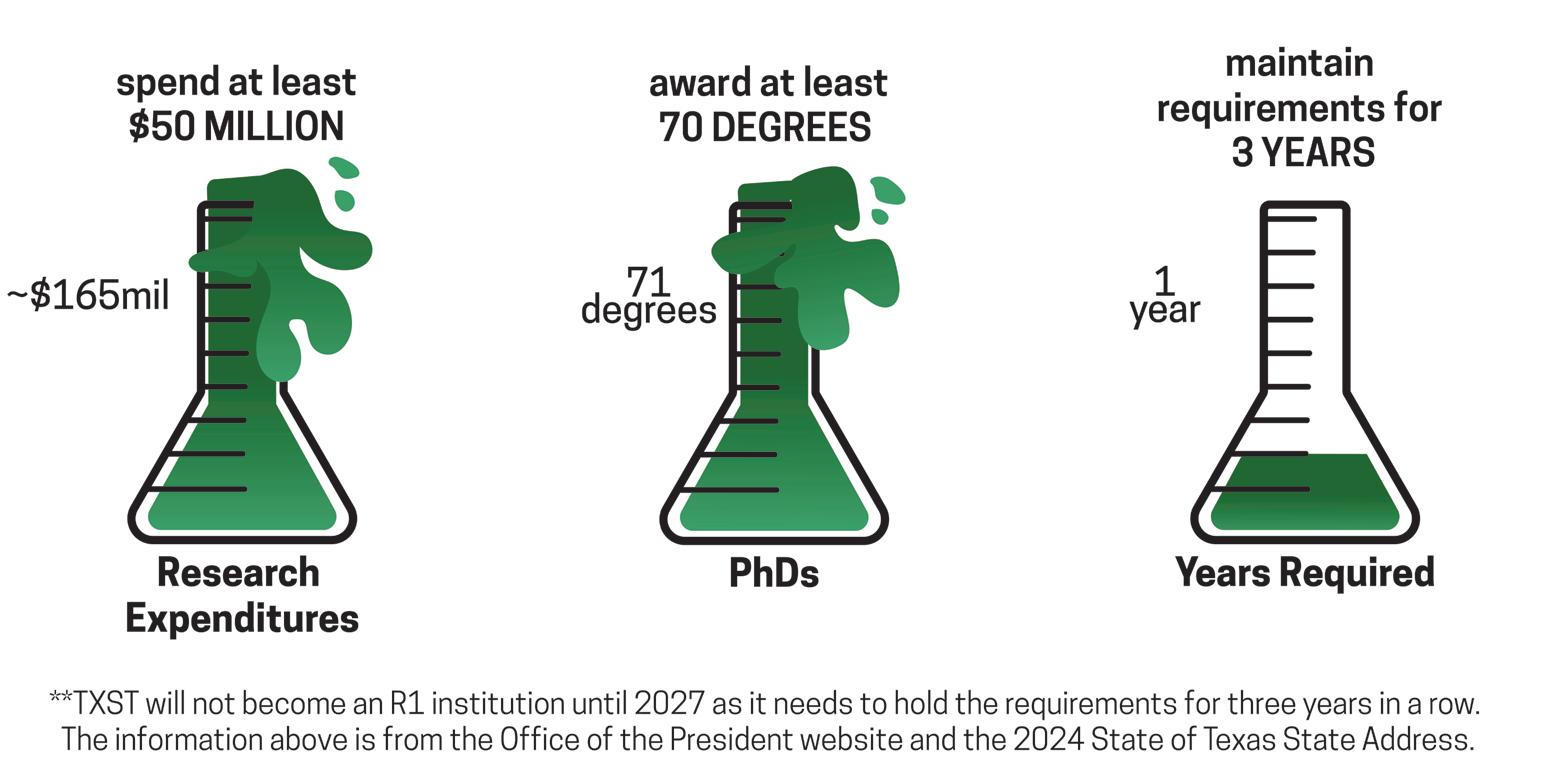
There are currently 16 universities in Texas that have reached R1 status, according to the Texas Higher Education Coordinating Board (THECB). Texas State is currently classified as an R2 research institution, which requires a minimum annual research expenditure of $20 million and the graduation of at least 20 doctoral students per year.
“Industries from all over the world are coming to Central Texas and they are looking for interns,” Mandayam said. “Over 90% of students remain in Central Texas, and [with R1 status] we are providing opportunities for them to
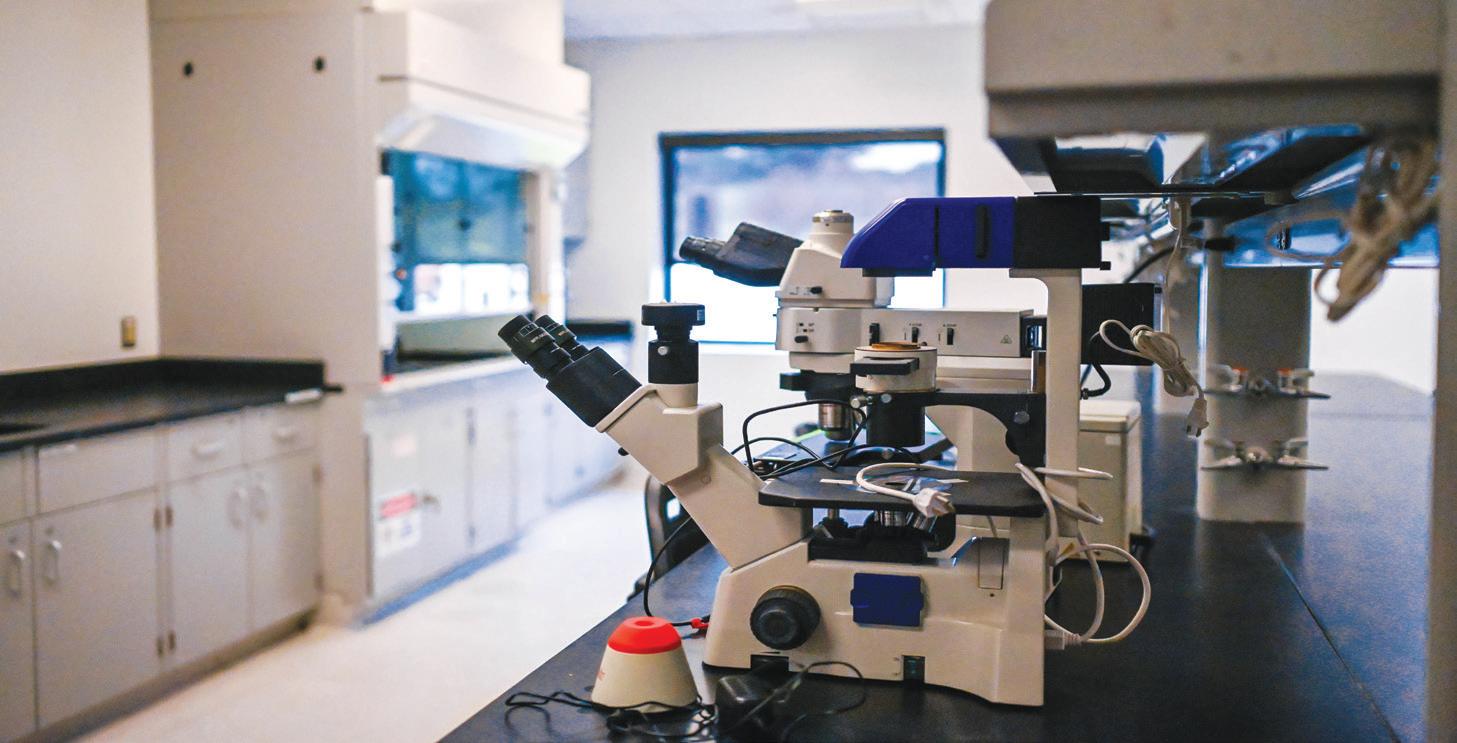
An inverted microscope sits on a table in an empty laboratory at STAR One, Wednesday, Feb. 26, 2025. STAR One is Texas State’s first technology incubator dedicated to research efforts.
FROM FRONT BUSINESS
“Food insecurity is you may have just eaten; you may not be hungry…but you don’t really know where your next set of groceries is coming from,” Young said. “You’re not really in a position where you would have the money to go to the store and know that you would be able to buy the food that you need to be healthy for the next period.”
San Marcos Mayor Jane Hughson said the community and H-E-B have been supportive, regularly donating and volunteering to address food insecurity.
“The availability of H-E-B or a grocery store is good. They’ve got a couple of their house brands that are specifically designed to be WIC [Women, Infants and Children] -eligible... designed to be a lower-cost option,” Hughson said.
However, some experts question how one grocery store will impact food access for the community. Cassandra Johnson, associate Texas State professor in the nutrition and
foods program, wrote many factors beyond availability influence food access.
“If people aren’t able to make enough money to meet their basic needs for food, housing, transportation, health care, dependent care for young children or other family members, then adding a new food store is unlikely to make it easier for them to get the foods they need for themselves or their families,” Johnson wrote in a statement to The Star.
At Texas State, the Food Security Learning Community launched Bobcat Bounty, a student-run pantry that is a partner site of the Hays County Food Bank. A portion of the items the Hays County Food Bank receives, which Bobcat Bounty gets food from, originate from H-E-B’s donations.
Natalie Powell, graduate instructional assistant and the Bobcat Bounty operations manager said food insecurity is prevalent within the student community and has significantly increased.

Trinity Building 203 Pleasant St. San Marcos, TX 78666 (512) 245 - 3487
Read more at universitystar.com
get jobs and remain right here.”
Texas State applied for 11 new PhD programs in spring 2024 with THECB; nine were approved.
According to Mandayam, Texas State is investing $50 million into the new PhD programs to support the program launch and student growth. The new programs will start in either fall 2025 or spring 2026.
Mandayam said as Texas State grows, it will focus on research opportunities in areas such as water, semiconductor chips, AI and digital and applied humanities.
Another key component of the Run to R1 initiative is the Science, Technology and Advanced Research (STAR) Park, where private companies collaborate with faculty and students. Established in 2013, STAR Park has supported a range of projects, from fire-retardant battery components to aquatic solutions. Currently, 11 companies are engaged in research and development within the park.
Mandayam said STAR Park is still in its early stages, with plans to grow as Texas State reaches R1 status and goals to give more research opportunities to Texas State students.
According to the Executive Director for STAR Park Harold Strong, the basic criteria for a company to work in STAR Park is to commit to
“People underestimate how prevalent food insecurity is...I think people have this idea of what a person who is food insecure looks like that might not be accurate,” Powell said. “Ultimately, right now, we’re seeing a lot of widespread, systemic issues that’ll hopefully get alleviated soon.”
H-E-B has yet to say when construction will begin. The rough timeline for the opening is winter 2026.
Scan the QR code to read H-E-B’s announcement.

Editorial Staff
Editor-in-Chief: Marisa Nuñez stareditor@txstate.edu
Managing Editor: Blake Leschber starmanagingeditor@txstate.edu
News Editor: Lucciana Choueiry starnews@txstate.edu
Life & Arts Editor: Carlene Ottah starlifeandarts@txstate.edu
Opinions Editor: Rhian Davis staropinion@txstate.edu
working with Texas State through shared research with the university and hire students to be a part of their company, one of those companies is CleverArium.
Strong said STAR Park’s growth is closely tied to Texas State’s pursuit of R1 status, noting that as more Ph.D. students join the university, STAR Park’s expansion opportunities increase.
Reaching R1 status would open more access to federal and state funding, Mandayam said.
“Students have to compete with students from across the country to get jobs. Now [with R1 status] they will be able to, because [Texas State] created these opportunities for them in research and education so they can be competitive and successful,” Mandayam said.
Mandayam said Texas State reaching R1 status boosts the local economy and increases retention by attracting new companies with jobs for Texas State students in the Central Texas area.
“[Run to R1] isn’t a race Texas State reaches; it is a situation that the university maintains and continues to grow. R1 is just one of the milestones,” Strong said.
Scan the QR code to read the 2024 State of Texas State address.


Publication Info
Sports Editor: Jackson Kruse starsports@txstate.edu
Multimedia Editor: Mandalyn Lewallen starmultimedia@txstate.edu
Engagement Editor: Diego Medel starengagement@txstate.edu
PIR Director: Katherine Andrews starpr@txstate.edu
Creative Service Director: Carson Rodgers starcreative@txstate.edu
History: The University Star is the student newspaper of Texas State University and is published every Tuesday of the spring and fall and once a month in the summer semesters. It is distributed on campus and throughout San Marcos at 8 a.m. on publication days with a distribution of 3,000. Printing is by the New Braunfels Herald-Zeitung. Director: Laura Krantz, laurakrantz@txstate.edu Advertising Inquiries Contact at: 512-245-3487 advertising@universitystar.com

Design Editor: Jen Nguyen stardesign@txstate.edu
Copyright: Copyright Tuesday, March 4, 2025. All copy, photographs and graphics appearing in The University Star are the exclusive property of The University Star and may not be reproduced without the expressed written consent of the editor-in-chief.
Corrections Policy: Errors appearing in the pages of The University Star and brought to our attention will be corrected as soon as possible.
Lucciana Choueiry | News Editor |
“Understanding that as a chief, I moved all of our other assignments like detective or mounted horse unit or therapy dog, and put them all into patrol. So now I have a good amount of staff out in patrol while I’m doing this rebuild,” Carmichael said.
Carmichael said he and his two assistant chiefs are taking on the workload the detectives and lieutenants had before he reassigned them. He also said the change in workload means that investigating cases and responding to non-emergency cases may take longer.
“The three of us, we’re absorbing everything as best we can,” Carmichael said. “It is impacting us as an organization. It means that a few people now are doing the work of many.”
Carmichael said UPD is currently expanding its online reporting tool, which he believes will make filing a police report more accessible for the Texas State community.
According to the International Association of Police Chiefs, difficulties hiring police officers is a national issue, with 78% of law enforcement agencies reporting difficulties hiring. They attribute the difficulties to differences in work culture between generations, shifting public perceptions of law enforcement and challenges in the hiring process.
Howard Williams, associate professor of criminal justice and former San Marcos police chief, agreed, stating generational differences in desired employment and shifts in police perception, particularly following summer 2020, have intensified the issue.
“People don’t want to do the job if they don’t feel like the public is going to support them,” Williams
said. “You obviously don’t do [policing] to get rich. Money is not a very good incentive because there’s not that much money in it.”
According to Williams, changes in the media landscape may also contribute to negative perceptions of police. He said with the rise of social media, exaggerated or one-sided content often gains more attention than balanced, vetted reporting. Williams added social media serves as the primary news source for younger generations, including potential police recruits in their 20s.

“You find a lot of things that pop up on social media,” Williams said. “Somebody who’s pissed about something goes on this long diatribe about how wronged they were, and everybody kind of accepts that as being the truth, when, in fact, they probably didn’t tell about two thirds of the story, and they aggrandized their view of it.”
According to Carmichael, the staffing situation is improving. While he does not have data to support this, he believes police recruiting nationwide is improving, citing his recent success in hiring additional officers.
The new UPD recruits come from various backgrounds. According to Carmichael, two of the new recruits are entry-level and graduated from the police academy in June, while the seven other
recruits are “lateral officers,” meaning they worked at another law enforcement agency in the past.
“Having said all of that, we have undertaken a real commitment to recruiting and recruiting the right people,” Carmichael said. “So as an example, our interview panels are comprised of students, faculty and staff. If you sat down today in a panel in another venue, that panel might just be comprised of law enforcement with one or two community members. Our model’s reversed.”
While UPD is making moves to end its shortage of sworn officers, it’s also increasing the number of Public Safety Officers (PSOs). PSOs are mostly responsible for checking security cameras and the blue emergency phones, ensuring facilities are locked and unlocked as necessary and parking enforcement, among other duties, including limited patrols.
According to Carmichael, UPD is expanding the number of PSOs by recruiting students.
Gage Whatley, criminal justice junior, was one of the first student PSOs. According to Whatley, his duties currently consist mostly of parking enforcement, traffic direction and assisting the Texas State community with issues such as flat tires or jumping dead car batteries.
Whatley said he enjoys the job and feels like it is allowing him to serve the Texas State community.
“It does give me experience into how a department functions, how the administration deals with the frontline workers, financing and budgeting and things like that,” Whatley said. “It’s really giving me a behind the scenes look before I actually join up with an agency.”

As of Jan. 1, 2025, the San Marcos population estimate is 90,988, with the average population projection for the year 2035 at approximately 142,000.
Michel said the student population shapes the business market in San Marcos.
“When the students are here, [businesses] have to have a successful plan in place to be able to make it through the low months, low population months, so that kind of sets the stage for San Marcos,” Michel said.
Businesses like Valentino’s are adapting to the students. The pizza spot is open until 3 a.m. ThursdaySaturday. After midnight on Saturday night, Cody Taylor, owner of Valentino’s Pizza and new owner of Grins said Valentino’s is filled with music and the city’s student population and that’s when he sees an increase in sales.
Leonardo Pozzobon, entrepreneurship specialist for Business & Community Lenders of Texas Business , said while reasons for business closures vary, some of the most common reasons are bad planning and over-leveraging or general market changes.
“A healthy economy also includes a lot of closing businesses just because not everybody is ready for that. Either some people just retire, some people want to move or some people just start without the proper planning and resources,” Pozzobon said.
Michel said it is essential for any business to develop a well-rounded business plan that details their financial and marketing moves.
“It takes time and effort, and so a lot of people plow ahead and start a business without plans in place,” Michel said. “If you fail to plan, you plan to fail.”
While businesses have closed their doors, San Marcos continues to be home to thriving local businesses.
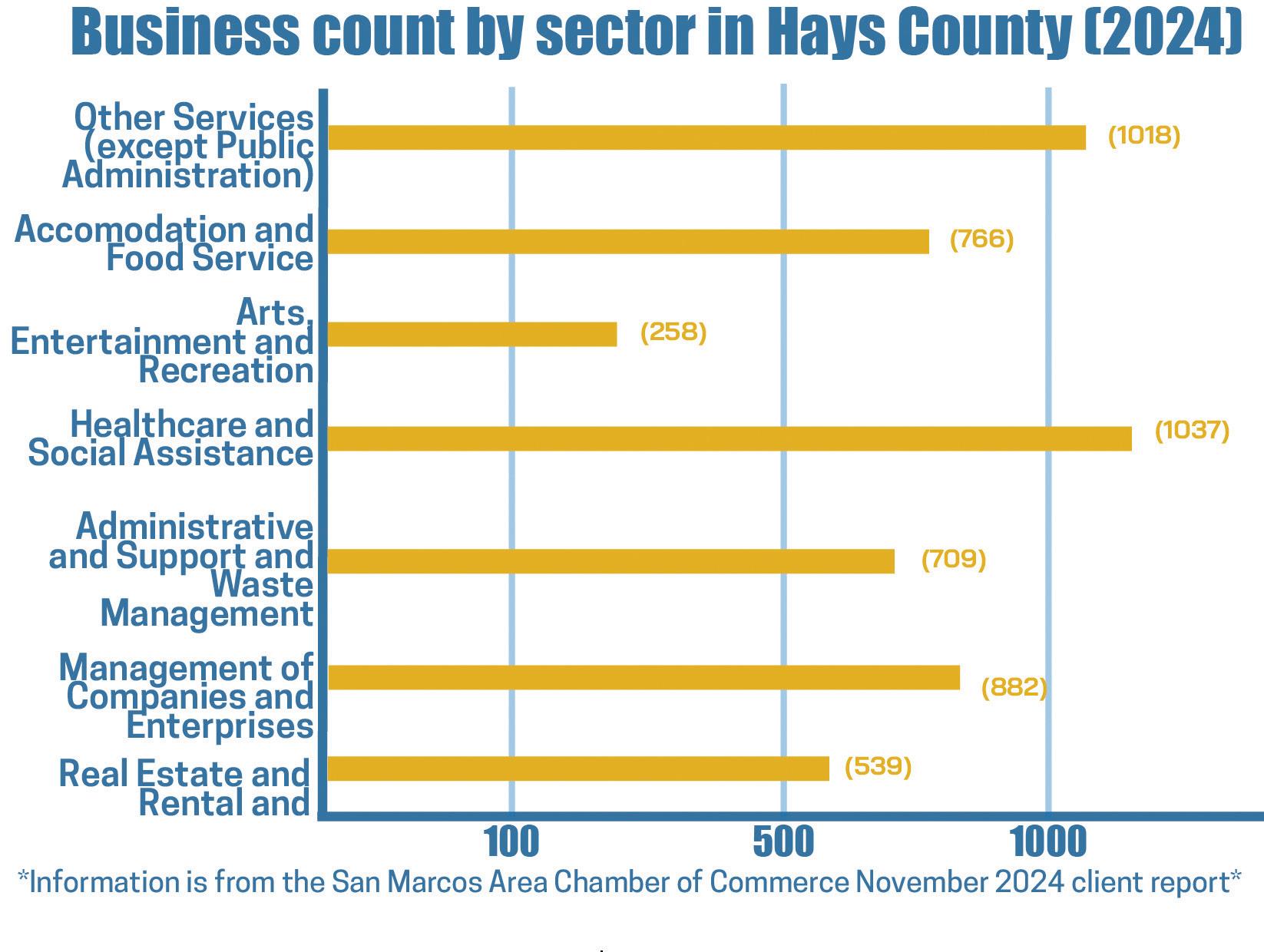
Kyle Mylius, founder, chief visionary officer and majority owner of the Taproot Restaurant Collective, which includes The Coffee Bar, The Root Cellar and Rhea’s Ice Cream, said there is support for locally-owned businesses in San Marcos.
“There’s a lot of people [who appreciate] the creative spirit that is in the DNA of some markets and the

local business more than a lot of other towns would, so that definitely helps,” Mylius said.
Mylius said one of the challenges they have faced is San Marcos’ low median income level. According to the U.S. Census Bureau, San Marcos’ median household income was $51,030 in 2023, while the national median household income was $80,610.
With the cost of goods and ingredients increasing, Mylius said it is important to make sure customers get the experience they are paying for.
“I think that’s something that gets glossed over in this town a lot because we have a very big successful university,” Mylius said.
Mylius said he adopts changes based on customer demands to provide a more efficient workflow. Root Cellar discontinued its dinner service on Feb. 14 and now offers only breakfast and lunch.
“It’s part of why we’re excited to focus on brunch because it allows us to do more and provide a higher level of brunch service than when we were trying to do three separate meals a day,” Mylius said.
Taylor said after reopening Valentino’s in 2022, there is extensive growth in popularity and business.
“I think that’s a competitive advantage when it comes to the restaurant business in general,” Taylor said. “Being able to bring back a staple of the community and then at that point you definitely have the job of doing a good job and hoping people enjoy the food and service.”
Taylor said minor changes in Valentino’s have helped the flow of the restaurant and brought a new environment while maintaining the restaurant’s history.
“I think we put out a stellar product, and it’s been received really well, and we’re gaining new regulars every day,” Taylor said.
Michel said as the population increases in San Marcos and Hays County, more business opportunities are expected to arise with the future of the city’s business market looking “nothing but bright.”
“A lot of people have an idea of what they want to sell, and then go out in the world to try to find a place to sell it, but what you actually want to do is find a location and find out what do these people need and want,” Michel said.
The University Star reached out to businesses in San Marcos that shut down but received no response.
March 4, 2025
Opinions in The University Star are not necessarily those of our entire publication, Texas State University’s administration, Board of Regents, School of Journalism and Mass Communication or Student Publications Board.
By Shar Kiefer Opinions Columnist
Texas and 16 other states involved as plaintiffs filed to sue Xavier Becerra, former secretary of Health and Human Services, after the Biden Administration added gender dysphoria as a disability under Section 504 of The Rehabilitation Act of 1973. However, the lawsuit calls Section 504 “unconstitutional” and plans for its removal entirely, actively posing a threat to disability rights.
Disability rights and Section 504 ensure equal opportunities for all students. Threats to these rights are inhumane and should be fought against.
Gavin Steiger, Texas State Disability Services director, said gender dysphoria could be a disability because it implies psychological distress within the person experiencing it.
“Psychological distress results from [inconsistency] between one’s sex assigned at birth and one’s gender identity,” Steiger said.
Section 504 prohibits discrimination against disabilities in any federally-funded facility. If the Supreme Court reviews Texas v. Becerra schools nationwide risk losing funding to support 504 plans, meaning Texas State could lose support for students with disabilities.
Ezra Schlicher, Bobcat Pride secretary said the trans community is an political easy target.
“I think trans people are an easy topic to get people riled up,” Schlicher said. “So if you have an agenda, that’s the fastest way to do it, especially within the conservative party right now.”
According to Texas Attorney General Ken Paxton, redefining Section 504 to include gender dysphoria as a disability is harmful to Texas because it would implement accommodations allowing “bathroom usage, pronoun usage and dress codes to be based on ‘gender identity’ rather than biological sex.”
Schlicher said Paxton’s reasoning creates more problems than it solves because it relies on misinterpretation.
“I think that almost dilutes the argument of accommodations in a way,” Schlicher said. “It also dilutes the argument of pronouns and bathroom usage, because they’re two very separate concepts and they exist in very different spaces.”
The National Center For Education Statistics states 21% of college students report having a disability and 54% of them identify as non-binary, an identity commonly categorized under the transgender umbrella.
Steiger said Section 504 protects those with disabilities under the use of federal funding.

While the Americans with Disabilities Act (ADA) would still be in effect if the case is ruled on, the acts each propose the counteraction of disability discrimination and how it is supposed to be handled. However, Section 504 is exclusive to The Rehabilitation Act which provides federal funding for 504 plans and encourages the elimination of disability discrimination.
Access Living stated successful attempts at eliminating Section 504 could lead to the targeting and possible overturning of other civil rights laws.
As of Feb. 19, a Joint Status Report for the review of the case was filed with the Department Of Justice, and it remains an ongoing federal case.
To advocate for the removal of the case, students can submit an online form with a complaint at the Texas
Attorney General’s website. Students with accommodations can speak to Disability Services at Texas State to ensure their safety. Additionally, students can get involved in student organizations already fighting.
“Join protests, I know there are things popping up in Austin right now especially, so if you’re able to get out there, look into it,” Schilcher said. “Join your on-campus groups. Do your research because a lot of these new legislations are very complex and the wording in them is very specific.”
It is vital for students to advocate for their disabled peers. The potential removal of Section 504 should not be an option.
-Shar Kiefer is a political science freshman
Speak On It is a collaboration of voices compiled by The University Star’s Editorial Board. Opinions expressed are not necessarily those of our entire publication.
By Staff
The University Star interviewed Muslim Student Association President Amina Shahid to gain her perspective on practicing Ramadan at Texas State.
Ramadan is the ninth month of the Muslim calendar and the holy month of fasting. For 30 consecutive days from Feb. 28 to March 29, Muslims fast from dawn until sunset. Shahid said in addition to abstaining from food and water, they also abstain from anything that would lead them to do something “morally incorrect.”
“The importance of this is to cleanse oneself of things that we indulge in our worldly lives,” Shahid said. “This is a reminder for us to connect back with God and a reminder of his blessings upon us.”
Shahid said completing the 30-day fast is a reminder that the patience one went through can also apply to the rest of the year.
Despite the significance Ramadan holds to Shahid and other Muslims at Texas State, she said there are often difficulties when practicing on a college campus. She said some issues lie within dining hall hours and halal options.
“When I was living on campus, I lived by Commons, which closed at 8 p.m. and my fast would open at 7:40 so I would never have time to go eat,” Shahid said. “[Dining halls] have halal chicken sometimes, and by sometimes I mean very rarely.”
Harris and Commons are open until 10 p.m. Monday-Thursday and for Ramadan, have extended hours on Friday and Saturday until 8:30 p.m. While this change is helpful for Muslim students, Shahid said there is more to be done.
Fasting times vary throughout the month and for students who have late classes, these extended hours might still not accommodate their fast.
“On March 9, we’re going to have daylight
savings kick in, so the time for [fasting to open] is going to move an hour later to 7:30. It’s different throughout the month because it changes by a minute or so throughout the day,” Shahid said. “I think we [need] more awareness going around the university.”
With the rise of conflict in the Middle East in recent years, Shahid said she notices a shift in attitude from both students and faculty.
“You’ll notice by The Stallions… statements saying ‘Islam is evil,’ ‘Muslims should go back’ and just other racist and Islamophobic comments,” Shahid said. “In classes too, I’ve noticed professors like to boast about being apolitical, but you do see backhanded comments that show their position about Israel and Palestine.”
Because of this, Shahid said there is a slight fear within the community. Muslim students have learned to not be too loud with their religion, culture or political standings to protect themselves.
Shahid said many people hold misconceptions or stereotypes about Islam, but they don’t take the time to learn about the religion or culture that surrounds it.
Shahid urges the community to take time to learn about Ramadan and the significance it holds to Muslims on campus.
The University Star welcomes letters from our readers. Letters must be 300 words or fewer to be considered for publication. Writers must include their full name, mailing address, major and academic year designation (for students), phone number and e-mail address when submitting a letter. Submissions that do not include this information cannot be published. This information is seen only by the editors and is used to verify the identify of the letter writer. It is not used for any commercial purpose.
Letters become the property of The Star and may be republished in any format. The letter may be edited for length and clarity. An editor will contact the letter writer if their letter is a candidate for publication. The Star will not run letters that are potentially libelous, discriminatory, obscene, threatening or promotional in nature. Letters can be submitted to staropinion@txstate.edu or by mail to Attn: Opinion Editor, The University Star, 601 University Drive, San Marcos, TX, 78666.
“Ramadan is a time for all of us to reflect upon all of last year and how we can become better people,” Shahid said. “If you’re inspired by it, it’s an opportunity for you to take a minute out of your day, even if you’re not fasting, to reflect.”









Tuesday, March 4, 2025
Throughout his performance, Edgar showcased his range of skills through a variety of musical selections. He drew on his formative years, delivering Latin-infused renditions of popular songs while also appealing to those who enjoy classical and blues genres. His musicality extended to his compositions, reflecting his ability to write across various genres.
Edgar received his degree in guitar performance from Oklahoma City University and turned his music into a career right out of college.
He gained international recognition after he uploaded an instructional video of “Bohemian Rhapsody” to YouTube. Over time, Edgar became, in Mark’s words, “one of the greatest transcribers of popular music for solo guitar.”
“I had no direction in high school,” Mark said. “Our parents didn’t talk about college. I didn’t know what I was going to do, and Edgar just sort of shot me into the whole thing.”
Cruz’s performance attracted long-time fans, Jorge and Nicole Rosales, San Antonio-based acoustic performers who shared their admiration for Cruz.
“I’ve been following him on YouTube for 15 years,” Jorge said. “As guitarists who’ve played together for fourteen years, his rendition of “Bohemian Rhapsody” captivated us and drew us to his music.”
For Edgar, performing at Texas State and connecting with the surrounding community held significance.
“I love connecting with any audience regardless of where I am, but I love this because my brother’s here,” Edgar said. “He’s been here forever. He always brings the best students and the best people from the community.”



By R.J. Porcher Sports Reporter
Junior Aiden Hayes is adding more accolades to his name after posting the third-best mark for the high jump in Texas State history.
Hayes jumped 7 - 4.25 (2.24m) during the Jarvis Scott Open on Feb. 15 in Lubbock, ranking him behind Charles Austin and Senior Kason O’Riley for the top records in Bobcat history.
“It felt like a surreal moment,” Hayes said. “To be third in Texas State history, just to be able to submit myself somewhere and try to leave it better than how I found it. It’s a good feeling.”
Texas State jumps coach Kendall Gustafson has worked with Hayes for the last three seasons. She said over the past couple of years, Hayes has grown tremendously, not only on the track but also off the track.
“[Hayes] just completely blossomed into this unbelievable kid and unbelievable athlete,” Gustafson said.
The mark Hayes posted on Feb. 15 not only placed him third in school history but also tied the fourth-highest mark in the entire NCAA in the high jump.
“You know how many guys [are] out there high jumping in the nation,” Hayes said. “It’s just a blessing [to accomplish this]; I’m trying to stay humble and just keep working like I’m never satisfied. I’m one of those guys, really.”
Hayes also competed in the high jump at the Sun Belt Conference Championship meet on Feb. 24 & 25, where he placed second for the Bobcats with a mark of 7-1.75 (2.18m).
Hayes isn’t the only Bobcat excelling in the high jump. O’Riley is also performing well during the indoor season and posted the second-highest mark in school history.
O’Riley said he and Hayes are good at matching each other’s energy.
“One of the best teams I’ve ever had,” O’Riley said. “If I do something good, [Hayes is] going to do something good also. We never put each other down [and] we always lift each other up. He’s a great teammate to work with.”
Hayes and Gustafson laid out a plan for the season: to bring back a gold medal.
“[I have] big goals and aspirations for me this year,” Hayes said. “I told [Gustafson] I wanted to win indoor nationals, and that was the goal, and we made it. Now, the goal is to go out there and succeed.”
With the indoor season wrapping up, Texas State’s outdoor season will begin on March 21 when it hosts the Charles Austin Classic.
“I’m trying to go back to outdoor nationals,” Hayes said. “Just staying consistent and building off the foundation I laid and going out there and accomplish my goals.”
Class: Junior Hometown: Plano, Texas
High School: Plano East
Career Accolades:
- 2024 NCAA West Prelim qualifier (high jump)
- 2023 NCAA West Prelim qualifier (high jump)
- 2024 All-Sun Belt Third Team (indoor)
- 2023 All-Sun Belt Third Team


By Jacob De Luna Assistant Sports Editor
A new partnership deal between Maroon and Golden (M&G) NIL Collective and Hangry Joe’s was announced on Feb. 17 via a post on X from M&G Collective. The deal aims to increase NIL funding for Texas State athletics and student athletes.
Per the announcement, the San Marcos-based restaurant Hangry Joe’s will donate 50% of its annual profits to the M&G NIL Collective. The deal is contingent on Hangry Joe’s selling an average of 1,000 meals every week.
“The goal is clear: by hitting this milestone, Hangry Joe’s can help secure NIL funding for Texas State student-athletes, enhancing their opportunities and supporting the future of Bobcat Athletics,” the announcement stated.
M&G Collective Board Member Thaddeus Watkins, a former Texas State football player (2010-12), said his interest in partnering with Hangry Joe’s began with a previous NIL deal led by restaurant franchisee Brandon Wilhem.
“Brandon did a deal last year with Ismail Mahdi, and I went to eat there after he did the deal with [Mahdi], so the marketing worked, and the food was great,” Watkins said. “Brandon, he is just a good person and is someone you wanna do business with. Before we partnered with him, he had done stuff with volleyball, women’s track and field, baseball, softball and football obviously.”
Watkins said the partnership will allow universities like Texas State to

ink deals with more athletes. It also creates more opportunities for Bobcat fans to engage with student-athletes. The deal allows M&G Collective to venture into working with other major sports at Texas State.
“We want to get into other sports as well because football has been the primary. We are into baseball [season] now,” Watkins said. “We also want to start working with basketball.”
Hangry Joe’s franchisee and area developer, Brandon Wilhelm, said M&G previously supplied Hangry Joe’s with merchandise and conversations about a partnership began there.
“I really liked where M&G was going as far as being all volunteer work and not being a for-profit company,” Wilhelm said. “I think it really benefits student-athletes more than anything.” Wilhelm said he hopes the deal can contribute heavily to Texas State athletics.
“I am hoping to write some big checks, it would help [Texas State] secure some athletes on the team(s). Schools the size of Texas State, with the whole NIL deal and profit sharing, it is a challenge for those schools to keep athletes,” Wilhelm said. “I looked at the numbers and I think we
can make some pretty big donations and keep some really good players if we hit this goal.”
M&G Collective Board Member
Justin Shaffer said the partnership deal between Hangry Joe’s and M&G will provide student-athletes with funds, assisting them with additional life expenses outside of athletics and school.
“If we are able to generate funds to sign these student-athletes to [NIL] deals, that is where the benefit comes from. It is for the additional [expenses] they are not able to take care of because they are so focused on Texas State athletics.”
Texas State women’s track and field athlete Melanie Duron, who recently took home the shot put gold medal at the Sun Belt Conference Indoor Championships, said the partnership will increase the amount of NIL deals Bobcat athletes receive and also contribute towards athletic gear and facilities.
“It is very hard to get NIL deals here. [M&G and Hangry Joe’s] contributing to us really helps because we will get to upgrade our weight room, get new uniforms as well as the other things we have already upgraded.”
Listed in the partnership announcement are several ways for Bobcat fans to join in and support M&G Collective. Every meal or gift card purchased as well as meal donations, will support the Hangry Joe’s and Maroon and Golden Collective mission to support Bobcat athletics.

Texas State junior Hector Garcia looks through a clothing rack during Bobcat Bazaar Thursday, Feb. 27, 2025, at the LBJ mall. Bobcat Bazaar occurs every Thursday, featuring a variety of student owned businesses.

Members of the San Marcos Youth Service Bureau wave and blow bubbles during the Mistick Krewe of Okeanos Mardi Gras Parade, Saturday, March 1, 2025, in San Marcos. The YSB is celebrating 50 years of service to the community.
Texas State social work junior Keira Diaz (Left) and social work senior Kene Smalls (Right) dish up mac and cheese, baked chicken, and cornbread during the Cookout, Wednesday, Feb. 26, 2025, at the LBJ Student Center. The Cookout closed out Texas States celebration of Black History Month.
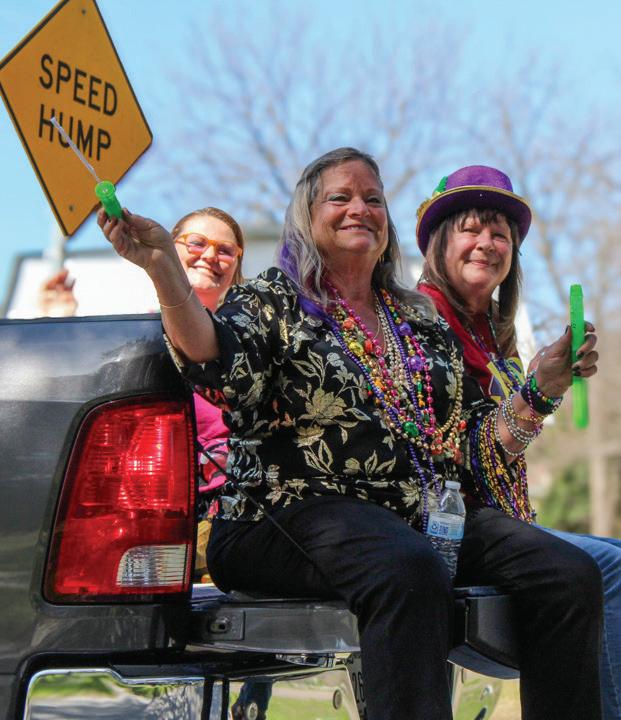
CANTU | STAR PHOTOGRAPHER


A local resident rides his unicycle in the Mistick Krewe of Okeanos Mardi Gras Parade, Saturday, March 1, 2025, in San Marcos. The Mistick Krewe of Okeanos hosts the parade annually, starting in 2017.

Rebecca Hudson aka Strawberry STOMPcake a member of the San Marcos River Rollers, rollerskates in the the Mistick Krewe of Okeanos Mardi Gras Parade, Saturday, March 1, 2025, in San Marcos. The San Marcos River Rollers are a local all female rollerderby team.
Members of the Hellcats, a co-ed spirit fraternity, cheeron the Bobcats during the men’s basketball game against Troy University, Tuesday, Feb. 25, 2025, at Strahan Arena. Troy beat Texas State 7469.
Members of multiple Black Greek-Lettered organizations dance in front of a crowd on Hump Day, Wednesday, Feb. 26, 2025, at the LBJ Mall. The National Pan-Hellenic Council, Inc. holds Hump Day twice a semester at Texas State.

